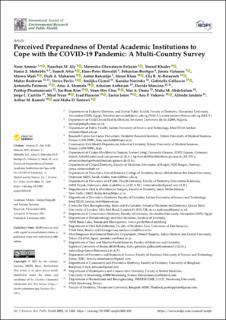Perceived Preparedness of Dental Academic Institutions to Cope with the COVID-19 Pandemic: A Multi-Country Survey
Ammar, Nour; Aly, Nourhan M.; Folayan, Morenike Oluwatoyin; Khader, Yousef; Mohebbi, Simin Z.; Attia, Sameh; Howaldt, Hans-Peter; Boettger, Sebastian; Virtanen, Jorma; Madi, Marwa; Maharani, Diah A.; Rahardjo, Anton; Khan, Imran; Al-Batayneh, Ola B.; Rashwan, Maher; Pavlic, Verica; Cicmil, Smiljka; Noritake, Kanako; Galluccio, Gabriella; Polimeni, Antonella; Shamala, Anas A.; Aarheiam, Arheiam; Mancino, Davide; Phantumvanit, Prathip; Kim, Jin-Bom; Choi, Youn-Hee; Dama, Mai A.; Abdelsalam, Maha M.; Castillo, Jorge L.; Nyan, Myat; Hussein, Iyad; Joury, Easter; Vukovic, Ana P.; Iandolo, Alfredo; Kemoli, Arthur M.; Tantawi, Maha El
Journal article, Peer reviewed
Published version

Åpne
Permanent lenke
https://hdl.handle.net/11250/2767822Utgivelsesdato
2021Metadata
Vis full innførselSamlinger
Originalversjon
International Journal of Environmental Research and Public Health (IJERPH). 2021, 18(4), 1445 10.3390/ijerph18041445Sammendrag
Dental academic institutions are affected by COVID-19. We assessed the perceived COVID-19 preparedness of these institutions and the characteristics of institutions with greater perceived preparedness. An international cross-sectional survey of dental academics was conducted from March to August 2020 to assess academics’ and institutional attributes, perceived preparedness, and availability of infection prevention and control (IPC) equipment. Principal component analysis (PCA) identified perceived preparedness components. Multilevel linear regression analysis assessed the association between perceived preparedness and fixed effect factors (academics’ and institutions’ attributes) with countries as random effect variable. Of the 1820 dental academics from 28 countries, 78.4% worked in public institutions and 75.2% reported temporary closure. PCA showed five components: clinic apparel, measures before and after patient care, institutional policies, and availability of IPC equipment. Significantly less perceived preparedness was reported in lower-middle income (LMICs) (B = −1.31, p = 0.006) and upper-middle income (UMICs) (B = −0.98, p = 0.02) countries than in high-income countries (HICs), in teaching only (B = −0.55, p < 0.0001) and in research only (B = −1.22, p = 0.003) than teaching and research institutions and in institutions receiving ≤100 patients daily than those receiving >100 patients (B = −0.38, p < 0.0001). More perceived preparedness was reported by academics with administrative roles (B = 0.59, p < 0.0001). Academics from low-income countries (LICs) and LMICs reported less availability of clinic apparel, IPC equipment, measures before patient care, and institutional policies but more measures during patient care. There was greater perceived preparedness in HICs and institutions with greater involvement in teaching, research, and patient care.
